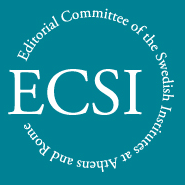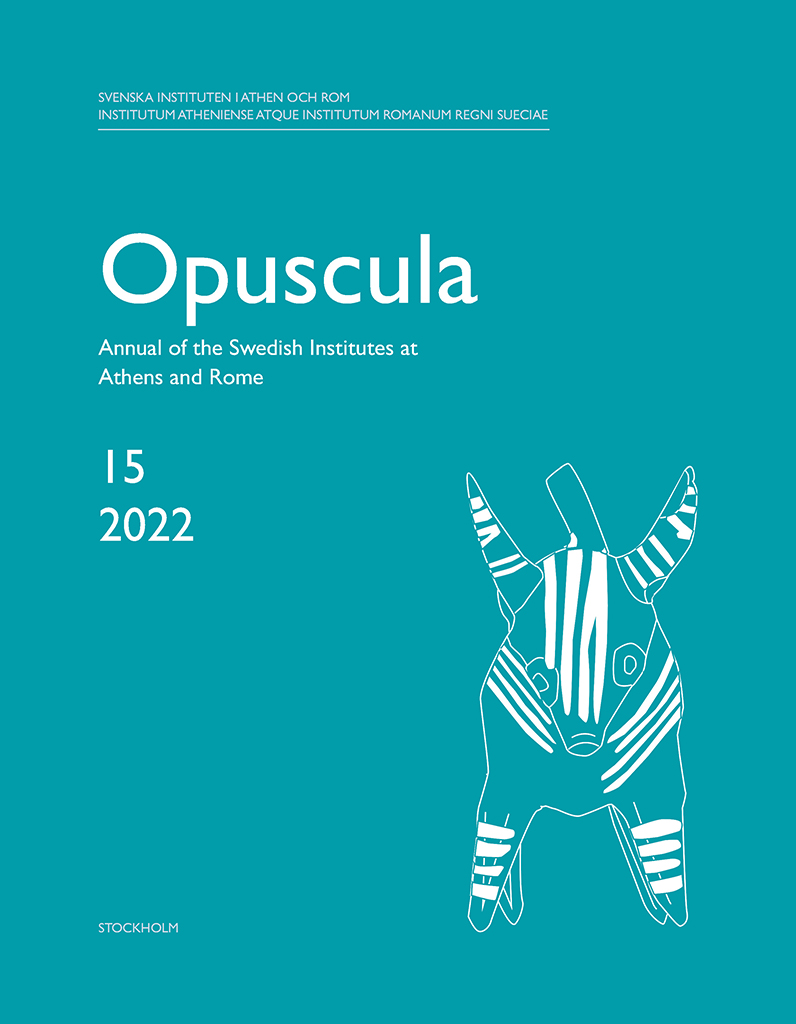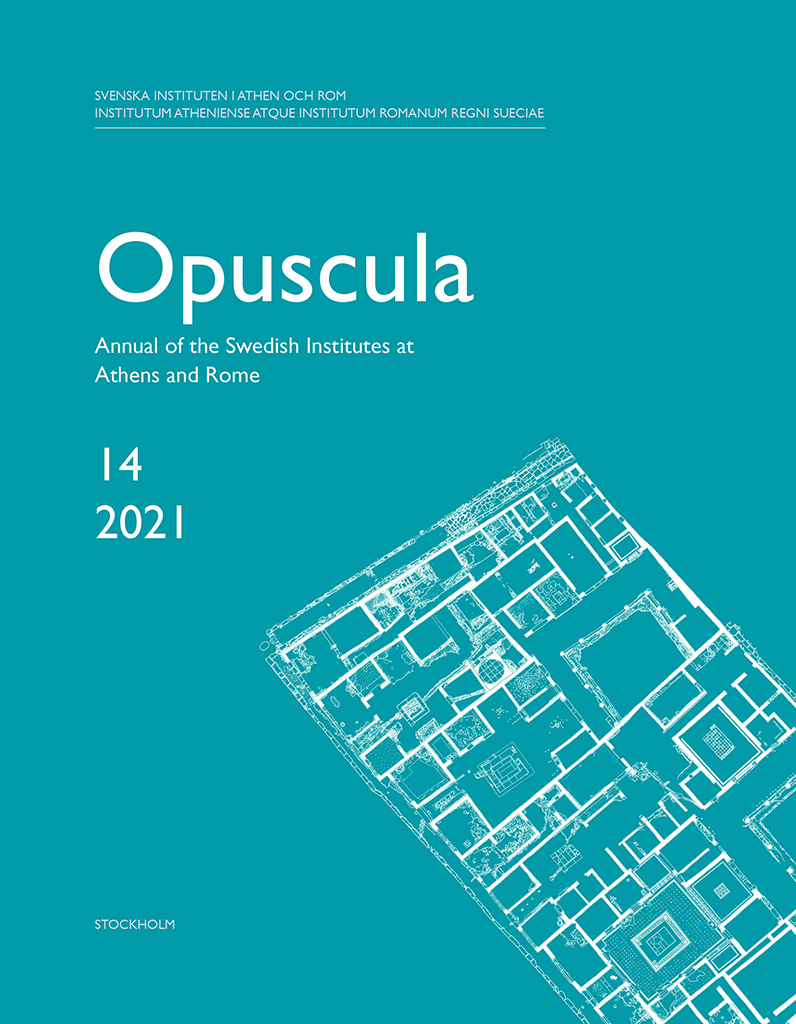Opuscula is published by the Swedish Institutes at Athens and Rome, with the aid of a grant from the Swedish Research Council. Distributed by Eddy.se AB. View journal at ERIH PLUS. All content available with open access. Roman and Early Byzantine evidence from the area of Palamas. A preliminary report of the ongoing Greek-Swedish archaeological work in the region of Karditsa, Thessaly By Maria Vaïopoulou, Robin Rönnlund, Fotini Tsiouka, Johan Klange, Derek Pitman, Sotiria Dandou, Rich Potter, Lawrence Shaw, Lewis Webb, Stelios Ieremias, Ian Randall & Harry Manley Abstract This paper presents preliminary results of the Palamas Archaeological Project relating to the Late Roman and Early Byzantine periods in the study area in western Thessaly, Greece. These periods are comparatively understudied in Thessaly, and the aim of this work is to highlight the extent of the material and the potential of investigating the archaeology of Late Antiquity in the region. The work was centred on excavations and survey at the site at Vlochos, alongside architectural survey at the neighbouring site on Kourtikiano hill. The paper also presents studies into Late Roman and Early Byzantine material found during cleaning at Vlochos. Additionally, an unpublished inscription spoliated in a church in nearby…
Opuscula is published by the Swedish Institutes at Athens and Rome, with the aid of a grant from the Swedish Research Council. Distributed by Eddy.se AB. View journal at ERIH PLUS. All content available with open access. The New Swedish Cyprus Expedition (The Söderberg Expedition): Excavations at Hala Sultan Tekke 2020 and 2021. Preliminary results By Peter M. Fischer & Teresa Bürge, with contributions by B. Placiente Robedizo, C. Eriksson, K.O. Lorentz, N.M. Branca, B. Casa, Y. Miyauchi, S.A.M. Lemmers, S. Kayalp, V. Vassallo, S. Florindi, S. Gasanova, S. Hermon, L. Avial Chicharro, E. Peri & B. Clark Abstract In 2020 and 2021, the eleventh and twelfth seasons of excavations at the Late Bronze Age city of Hala Sultan Tekke were carried out in the cemetery of Area A. Based on indications provided by a large-scale magnetometer survey, two tombs exposed by intensive farming were located, Tombs RR and SS. The excavation of Tomb RR, which had started in 2018, was concluded. The total minimum number (MNI) of skeletons in this tomb, of which most were incomplete and disarticulated, is estimated at 137. In addition to clay figurines, seals and scarabs, objects of ivory, as well as jewellery of gold, silver,…
Opuscula is published by the Swedish Institutes at Athens and Rome, with the aid of a grant from the Swedish Research Council. Distributed by Eddy.se AB. View journal at ERIH PLUS. All content available with open access. The Invitation to the Dance. An intertextual reassessment By Julia Habetzeder (Uppsala University, Sweden) Abstract With its original manifestation generally dated to c. 150 BC, the Invitation to the Dance is a textbook example of Hellenistic sculpture. But despite much scholarly attention there is still no consensus as to what motif the sculpture group depicts. Inspired by intertextual theory, this study catalogues and re-examines 35 sculptures of the female figure and 34 sculptures of the satyr. The article focuses on preserved sculptures, rather than a reconstructed model image. Variations of the repeated forms are highlighted as significant for the interpretation of the types. The reading of the Invitation to the Dance thus put forward suggests that the group composition displays the moment after the satyr has pulled the female’s garment down from her upper body. It is furthermore emphasized that both satyr and female figure were at times—perhaps even predominately—displayed as solitary figures. The satyr’s foot-clapper is suggested to have been included primarily in…
Opuscula is published by the Swedish Institutes at Athens and Rome, with the aid of a grant from the Swedish Research Council. Distributed by Eddy.se AB. View journal at ERIH PLUS. All content available with open access. Commending a freedman. Virtues and masculinities in the recommendation letters of Cicero and Pliny the Younger By Lisa Hagelin (Uppsala University) Abstract This article explores Roman freedmen’s masculine positions expressed as virtues, qualities, and ideals in the recommendation letters of Cicero and Pliny the Younger. It discusses whether there were specific freedman virtues, qualities, and ideals and what consequences their existence or absence had for freedmen’s constructions of masculinity. A critical close reading of the texts is applied, combined with theories of masculinity, where hegemonic masculinity is a key concept. It is concluded that there were no virtues or qualities that were specific or exclusive to freedmen. A distinct set of virtues for freedmen did not exist in Late Republican and Early Imperial Rome, since much the same behaviour and qualities are seen as manly and desirable for freedmen as for freeborn male citizens of high birth. However, freedmen cannot comply with the hegemonic masculinity in full, since they cannot embody the Roman masculine…
Opuscula is published by the Swedish Institutes at Athens and Rome, with the aid of a grant from the Swedish Research Council. Distributed by Eddy.se AB. View journal at ERIH PLUS. All content available with open access. The Temple of Zeus at Lebadea. The architecture and the semantics of a colossus By Chrysanthos Kanellopoulos (National and Kapodistrian University of Athens, Greece) & Elena Partida (Hellenic Ministry of Culture & Sports, Greece) Abstract The Temple of Zeus Basileus at Lebadea rests almost unknown. Its physical remains and date (not systematically explored so far) pose a riddle, as regards not only the circumstances which entailed its presumed incompletion but also the historic context in which the commencement of construction can be embedded. The dimensions of the krepis alone render this edifice highly interesting in the history of temple-building. The in situ preserved architectural elements suggest that here was begun the erection of what was at the time the largest peristasis in Mainland Greece. The temple stylobate measures 200 feet/podes in length, with a lower column diameter equal to just over two metres, and the longest interaxial spacings and corresponding architraves of its time. By increasing the length and height of the structure,…
Opuscula is published by the Swedish Institutes at Athens and Rome, with the aid of a grant from the Swedish Research Council. Distributed by Eddy.se AB. View journal at ERIH PLUS. All content available with open access. The Turkish harem in the Karyatid Temple and antagonistic narratives on the Athenian Acropolis By J.Z. Van Rookhuijzen (Utrecht University, The Netherlands) Abstract According to received history, the Karyatid Temple on the Acropolis of Athens (commonly known as the “Erechtheion”) was, in the city’s first Ottoman period (1456–1687), converted into a Turkish harem. In this article, I investigate the story by scrutinizing sources from this period. I argue that the notion of the harem, although historically suspect, found fertile ground in an orientalist worldview that has been prevalent among western visitors and scholars. I propose that the tale may have been inspired by the temple’s conspicuous Karyatid statues. I close by considering the story of the harem as part of a phenomenon of “antagonistic narratives” (stories that concern the desecration or destruction of monuments by enemies) in history and archaeology. The article offers new perspectives on later uses of and stories about the Karyatid Temple, on western attitudes towards the presence of Turks…
Opuscula is published by the Swedish Institutes at Athens and Rome, with the aid of a grant from the Swedish Research Council. Distributed by Eddy.se AB. View journal at ERIH PLUS. All content available with open access. Bulls and rams. The sacrifice to Erechtheus By Jenifer Neils (American School of Classical Studies at Athens, Greece) Abstract The earliest literary reference to animal sacrifice in Athens is the passage in Homer’s Iliad (2.550–551) that mentions Athenian youths propitiating their legendary king Erechtheus with bulls and rams. It is surprising that this passage has not been associated with the north frieze of the Parthenon, where twelve young men are leading four bovines and four sheep to sacrifice, in contrast with the ten cows on the south frieze which clearly represent the hecatomb for Athena Polias at the Panathenaia. While it is difficult to ascertain the sex of these eight animals, the horns and size of the sheep suggest that they are male. Given the prominence of the cult of the hero Erechtheus on the north side of the Acropolis, it is reasonable to identify these sacrificial animals as an offering to the pater patriae of the Athenians. Bibliographical information Jenifer Neils, ’Bulls and rams. The…
Opuscula is published by the Swedish Institutes at Athens and Rome, with the aid of a grant from the Swedish Research Council. Distributed by Eddy.se AB. View journal at ERIH PLUS. All content available with open access. Ancestral and chthonic cults at Tenos By Nota Kourou (University of Athens, Greece) Abstract This paper presents the material evidence from two neighbouring Early Iron Age sites at Xobourgo on Tenos, identified as sacred places, and comments on their religious character and evolution. The first, conventionally named the Pro-Cyclopean Sanctuary, has a purely mortuary character. It starts in the Late Protogeometric period with an ancestral cult on a pebble platform over an empty grave, continues with a number of pyre pits inside enclosure walls, and ends up with a chthonic cult at an eschara in the Late Geometric period to be replaced by a small sacred oikos in the 7th century. The second starts as an open-air shrine, named the Pre-Thesmophorion Shrine, with an eschara and a protected place for storing pithoi, and it is turned into a Demeter sanctuary, a Thesmophorion, with a small temple in the Classical period. After considering the development and phases of both sites, it is claimed that…
Opuscula is published by the Swedish Institutes at Athens and Rome, with the aid of a grant from the Swedish Research Council. Distributed by Eddy.se AB. View journal at ERIH PLUS. All content available with open access. The death of infants in Early Iron Age Cyprus. A jar burial from Kition-Bamboula By Sabine Fourrier (Maison de l’Orient et de la Méditerranée Jean Pouilloux, France) & Anna Georgiadou (University of Cyprus, Cyprus), in collaboration with Bérénice Chamel (Maison de l’Orient et de la Méditerranée Jean Pouilloux, France), Nathalia Denninger (Bibliothèque Nationale de France, France), Armelle Gardeisen (Université Paul Valéry, France), Katerina Papayanni (National and Kapodistrian University, Greece) & Tatiana Theodoropoulou (Cultures et Environnements Préhistoire, Antiquité, Moyen Âge, France) Abstract During recent excavations of the French Archaeological Mission at Kition-Bamboula, in modern day Larnaka, Cyprus, an infant jar burial was discovered. It was found under a floor layer in a domestic context, and is dated to the beginning of the Late Cypriot IIIB period (end of the 12th– early 11th century BC). This jar burial is part of a series which seems to be attested, at least in the present state of documentation, only in eastern Cyprus (Enkomi, Salamis and, on a…
Opuscula is published by the Swedish Institutes at Athens and Rome, with the aid of a grant from the Swedish Research Council. Distributed by Eddy.se AB. View journal at ERIH PLUS. All content available with open access. Palaepaphos-Teratsoudhia Tomb 288 (c. 1650 BC–c. 1200 BC) By Vassos Karageorghis (University of Cyprus) & Efstathios Raptou (Department of Antiquities, Cyprus), with appendices by Alexander Donald, Gisèle Clerc & Anna Spyrou Abstract This paper presents a new tomb complex of the Late Bronze Age at Palaepaphos-Teratsoudhia in south-west Cyprus. Although looted, Tomb 288 yielded a representative repertoire of funerary gifts, including seals and scarabs, ranging chronologically from the very beginning of the Late Bronze Age to Late Cypriote IIC, roughly from 1650 to 1200 BC. Tomb 288 has characteristics which are typical of Late Bronze Age tomb architecture in Cyprus and well known in the Paphos region, as well as aspects which have not previously been observed in any necropolis of the period, such as the large central “pillars” which support the roof in Chambers A and B. The tomb’s finds comprise representative examples of the ceramic production of Palaepaphos for a period of some 400 years and illustrate the wealth of this…


